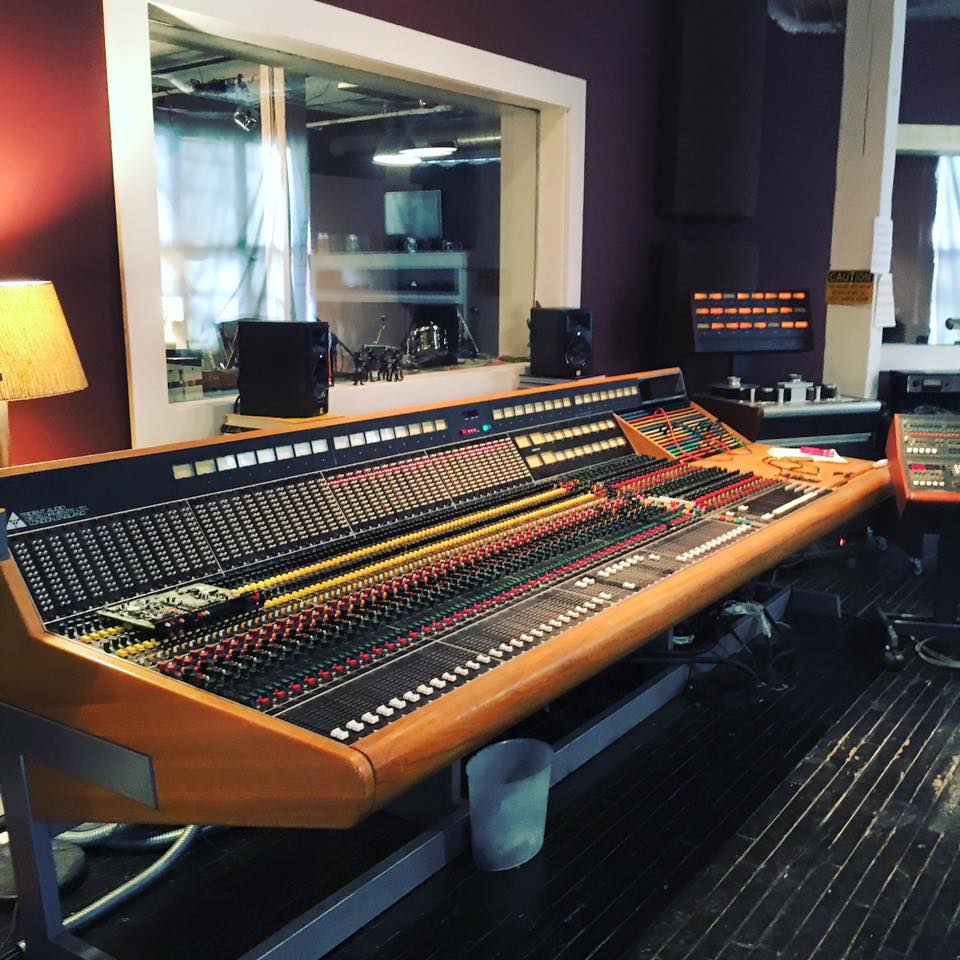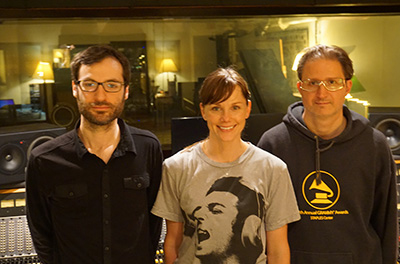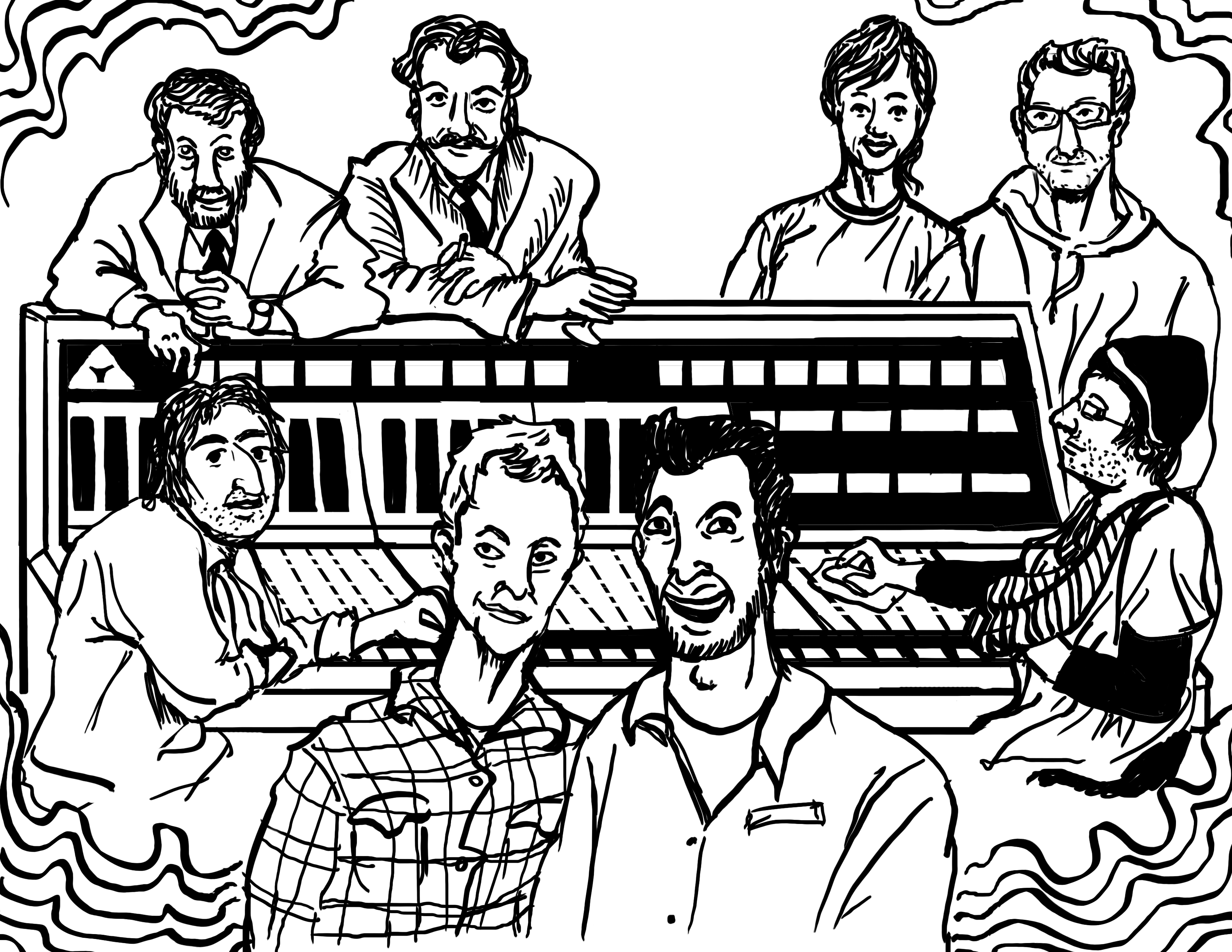The Trident TSM #9: Chicago’s link to the Beatles and rock royalty
The sort of unseen, disappearing player in all the records being made today is collaboration – between artists, engineers and producers and studio musicians – all those people.
Brian McTear, Miner Street Recordings
On a brisk day in early February, Matt Gieser shows off the pre-stages of construction for Treehouse Records’ growing space for music rehearsal studios. Treehouse Records is primarily an analog recording studio, but since its opening in 2013, renting out the studios to musicians has been a great way to keep the lights on. Considering the dwindling number of recording studios in Chicago, it certainly makes good business sense.
Gieser and his good friend Barrett Guzaldo opened Treehouse Records after dropping out of school for entrepreneurship and audio recording, respectively. After presenting a 30-page business plan to Gieser’s father, who owned a building near Diversey and Cicero avenues, the pair began converting an old gym into a vintage recording studio. Studio A is essentially a 10,000-square-foot living room with some separation for the drum set to suppress the sound. Separated by a wall with a wide glass window is the control room where they first installed their 24-track mix board, a Soundcraft Ghost LE, as well as a Tascam tape machine which had previously lived in Guzaldo’s living room.
While many musicians nowadays record straight to their laptops, Guzaldo maintains the belief that true creativity doesn’t come from copying and pasting sounds with software. He disagrees with people who think that recording straight to tape is limiting. “If ‘Dark Side of the Moon’ can be recorded on a tape machine, you can record anything. The Beatles recorded [‘Sgt. Pepper’s Lonely Hearts Club Band’] on a four-track tape machine,” Guzaldo says. Now, Treehouse Records has a 24-track tape machine with plans to buy another.
In Treehouse Records’ first few years, they were able to land a partnership with Chicago-based music blog “Consequence of Sound,” which allowed them to record sessions with chart-topping bands like Cage the Elephant and Violent Femmes. They also recorded many of Chicago’s popular garage rock bands like White Mystery and Twin Peaks. With a tight-knit group of musicians as their clientele and the steady income from rehearsal spaces, Treehouse was able to gradually build capital and purchase more equipment.
When Gieser heard news that Paragon Studios in the West Loop of Chicago was going out of business, he called them about buying their mix board right away. The mix board in question? The newly refurbished, 1979 Trident TSM #9.
After three months of negotiations with Paragon Studios, the mix board was finally delivered to Treehouse Records. The Trident TSM #9 is 13 feet long and cased in varnished wood.
Trident Studios was a recording studio in London which opened in 1968 and had a hand in recording many of England’s quintessential rock acts. The Beatles, David Bowie, Elton John, T. Rex, and Queen to name a few. The owners of Trident studios, Norman and Barry Sheffield, were obsessed with staying on top of industry trends. They were the first in England to receive an eight-track tape recorder which allowed for richer, more layered songs.
Trident’s eight-track first lent its hand to The Beatles’ tracks “Hey Jude” and “Dear Prudence.” Norman Sheffield claims in his autobiography that “there was no doubt in my mind that [The Beatles] would be blown away by the possibilities our eight-track opened up for them.” The Beatles recording at Trident launched the studio into success. In less than a year, they had produced four top-10 singles and were able to upgrade equipment to accommodate 16-track recording.
Malcolm Toft began at Trident as a studio engineer and eventually moved up to be studio manager. Toft suggested to the Sheffield brothers that they should build their own mix-desk to accommodate feedback from the engineering team. Toft finished the first “Trident A-Range” console, of which only few were made and are highly sought-after pieces of equipment. After the “A-Range,” Toft continued engineering and manufacturing a series of professional quality audio mix boards under the subsidiary company, Trident Audio Developments. Toft stayed with the company until 1988.
Each one of the Trident TSM #9’s 48 tracks is a duplicate vertical strip of red, white, and yellow faders topped with a line of red lights. Each track corresponds to a unique sound, typically amplified by a microphone, which can be manipulated and monitored through the mix board. Through the board, you can adjust the volume, reverberation, or add delay to certain sounds. It also has “EQ” options which affects various frequencies in a sound and can highlight bass notes or high-frequency noises, or attempt to level them out.
The 1979 Trident board fits in well with Treehouse Records’ ethos to preserve the past. There are few things at Treehouse Records, besides the people, that date past 1980.
A few weeks before the Trident mix board is fully installed in the Treehouse control room, Gieser and Guzaldo think about redecorating their studio.
 Gieser is obsessed with 1970s nostalgia. He loves electric organs, jukeboxes, neon signs, muted paisley rugs, anything he can find that has a story from another time. Studio A is cluttered with all of this, and more, considering the fact that there has to be room for instruments and actual recording equipment.
Gieser is obsessed with 1970s nostalgia. He loves electric organs, jukeboxes, neon signs, muted paisley rugs, anything he can find that has a story from another time. Studio A is cluttered with all of this, and more, considering the fact that there has to be room for instruments and actual recording equipment.
Gieser has collected more than five organs in the last few years, but not all of them were worth keeping. Guzaldo is the one who lets him know when to throw things out, but Gieser remains sentimental about certain objects. That’s where having extra space like the lounge areas outside of Treehouse’s rehearsal space comes in handy. A Thomas Organ like the version played on the Lawrence Welk show, which lights up when you press the keys, is immortalized in the same room where guys hang out to play Nintendo 64 games and take a break from playing loud music.
Guzaldo is mostly a fan of Gieser’s collectibles, at least for their aesthetics. But when it comes to actually recording, the “JUST SAY NO DRUGS” neon makes guitar amplifiers buzz, and there’s a giant elephant head on the wall above the more valuable electric organs that’s just hanging on by a thread. They’ve talked about taking everything off the walls and painting them white. Although the decorations might not help with recording functionality, they have certainly provided Treehouse with a marketable point of view. “We built it when we were 20. It’s not as soundproof as it should be. It’s not wired as well as it should be. But it has character, nostalgia, and feeling,” Gieser says.

Gieser, Guzaldo and his band member Chris are hanging out in Studio A, contemplating what they would bring with them if Treehouse were burning down. Guzaldo would strap three guitars to his back: the 1960s Guild acoustic guitar, the Chet Atkins Gretch Hollowbody guitar, and the baby guitar he bought at CVS for sentimental value.
But really, he’d try to shove as much stuff onto the elevator as possible and hope he makes it out alive, even if he’s got some fire on his back.
“If you burn down with this place I would be so golden,” Gieser says.
“For what – life insurance?” Chris responds.
“Probably for insurance on this place,” Guzaldo says.
“No,”
Matt says laughing,
“Then I’d get everything!”
The process of music-making has certainly been romanticized by movies or by musicians themselves. Images of reel-to-reel tape unspooling, clunky silver-plated microphones, a full studio band, and the record producer behind a sprawling mix board nitpicking the band’s sound. These elements associated with a golden era of recording have been compromised in the digital era. Tape machines have essentially been replaced by recording software, which is much cheaper and easier to maintain, and allows for infinite customization.
Through all of it is an awareness that music-makers must speak an entirely different language in order to achieve the goal of evoking emotion through music. Whatever the final emotion might be, the process of getting there is tedious.
When the Trident TSM #9 was still at Paragon Studios, it underwent a major restoration. It took chief engineer Joe Connors and technician Darryl Yount over a year to restore the Trident board to its original state through trial and error and plenty of soldering.
Before Connors began as chief engineer at Paragon, he was studying music composition at the University of Montana* when an injury prevented him from continuing to play the cello. He knew nothing about audio recording, which is exactly why the previous engineer at Paragon wanted to hire him. Connors was told that “monkeys could turn knobs,” but not everybody was able to identify layering and music scope the way that somebody who studied composition could do. After spending a few months transcribing music for clients and working the parking lot for the adjacent music venue The Mid, Connors was proclaimed the head engineer at Paragon Studios. He still had little to no knowledge of recording.
“You can be empowered by your environment, people or your future. What Paragon did for me was exactly that. I felt that I was somewhere famous or special. I put myself in the headspace to deal with that fact,” Connors says.
Connors was dedicated to absorbing everything there was to learn at Paragon, from proper micing techniques to bureaucracies within the music business. A man named William “Kelly” Milionis, who often visited the studio with his students from Central Michigan University, quickly became a mentor to Connors. Milionis brought the knowledge of years of experience in the music industry which gave Connors someone with whom he could “reference his ideas.” He considers Milionis to be responsible for his ability to be able to tackle difficult tasks.
Milionis is a magnet for eager, curious people. He was born with a rare heart condition which has put him through many surgeries and treatments. In late November 2014, Milionis was hospitalized in Indianapolis and his outlook on life was very bleak. His last hope was a young doctor who ordered him an echocardiogram which was given by an ultrasound specialist named Liz Lauer. A procedure that typically lasts twenty minutes was extended to an hour and a half as Lauer and Milionis continued talking.
With Milionis’ background in music recording, Lauer became fascinated with the glamorous element of it all. Plus, how cool was it that they both manipulated sound waves for their jobs?
After receiving a life-saving experimental heart procedure, Milionis was back to managing artists and he invited Lauer to come to Paragon in Chicago to experience a recording session.
Milionis was recording on the weekends at Paragon Studios with the Robert Lee Revue, a jazz group. He invited Lauer to come along.
In spring 2015, Lauer embarked on her first of many trips to Chicago. She pulled up to a large black brick building which served as music venue The Mid and a fish market. On the Green Street side, a black door with a sign taped on it read “Paragon Studios” imposed over an orange triangle logo.
The studio had a cozy vibe, with curtains and lamps warming the space. In the control room, the Trident TSM #9 demanded attention for its size and purpose. It was the fixture around which conversations about the tone and mood of a record were going to sound. Joe Connors describes the board as the canvas on which music could be painted.
Once Lauer sat through a recording session, her ears could pick up what they were talking about. It was the subtle differences that she had never noticed until seeing somebody like Connors behind a mix board, physically manipulating the sound.
Connors was able to show Lauer what it looked like to change the amplification of a certain sound, or what it meant to add more reverb to a mix. After sitting through a mix and seeing how Connors and Milionis interacted with the band, she was hooked. Lauer explains that being at Paragon made an “uncool person feel cool.” She became an ultrasound tech by week and a record producer on the weekends. Once she received credits on Robert Lee Revue’s single “JazDude,” it was no longer her secret vocation but rather a legitimized product.
With Paragon Studio’s location in the popular Fulton Market District of Chicago, everybody could feel that the end was near. Rents were rising as more business began opening up on “restaurant row,” not far from Paragon Studios.

Now, Lauer travels with ultrasound tech selling equipment. Milionis continues to record with Connors, now bringing Connors to Indianapolis. Connors became interested in developing technology and owning intellectual property. “I struggled at Paragon and not having control over the job,” Connors says. Now that he has seen the smoke and mirrors of the music business, he wants to be in control. But the Trident TSM #9 has not escaped Connors’ grasp quite yet. When Gieser and Guzaldo were installing the board, they needed his help with wiring and he was happy to oblige.
Treehouse Records recently held a two-year anniversary party where they revealed the Trident mix board to their friends and family. The party was supplied with free Revolution beer, had a Burton snowboarding booth, and a chance to win free vinyl. Having the patience to install the board was worth it for Gieser, who says that their first recording on it showed a night-and-day difference. He’s glad that Treehouse is its home, and they’ll keep coursing electricity through its veins.
We had a couple of things going for us that were setting us apart from the competition [..] A lot of people were coming over just out of curiosity to see what our equipment could do. [..] But our popularity came mostly due to the aura that was building around the place, the idea that we were a young “happening” place. The era of laboratory recording studios really was coming to an end. People wanted to be surrounded by young, creative people. They wanted to bounce things off of each other. We were always happy to accommodate this.
Norman Sheffield, Life on Two Legs
*This line has been corrected from the original, which misstated where Joe Connors went to college.
Header illustration by Sydney Kosgard of, top left to right: Barry and Norman Sheffield, Liz Lauer and William “Kelly” Milionis. Bottom left to right: Malcolm Toft, Barrett Guzaldo, Matt Gieser and Joe Connors.
Photos, top to bottom: The Trident, fully installed at Treehouse Records. Photo by Matt Gieser. Joe Connors, Liz Lauer and Kelly Milionis at Paragon Studios. Photo by Ned Englehart. Video by Consequence of Sound.




NO COMMENT